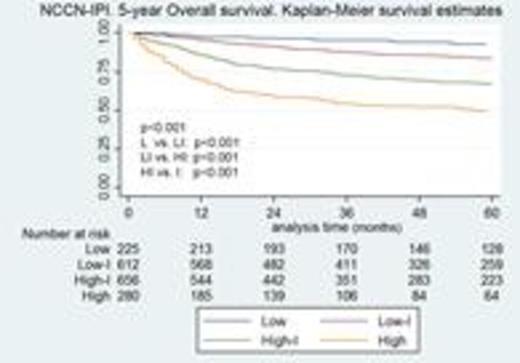Abstract
The development of the NCCN International Prognostic Index (NCCN-IPI) for patients with DLBCL treated in the rituximab era improves discrimination when compared to the original IPI model. The aim of the present study is to validate the results of the NCCN-IPI in a large independent series of patients in a different geographical area.
Materials & Methods. This nation-wide retrospective study includes 2156 patients with de novo DLBCL diagnosed in 20 (mostly) large academic Spanish centers within the Grupo Español de Linfomas y Transplante de Médula Osea (GELTAMO) network between 1998 to July 2014. Patients had to be ≥ 18 years-old, treated with rituximab plus chemotherapy (R-CHOP or variants and also more intense treatments) and a minimum of 1 year of follow-up; all histological subtypes of DLBCL and primary extranodal cases were acceptable, with the only exclusion of primary testicular or CNS sites. In the whole series the scoring of the IPI and NCCN-IPI indexes were used and 5-year Overall Survival (5y-OS) estimated with the Kaplan-Meier method and compared with the log-rank test.
Results. Debugging the database resulted in a final working series that included 1885 patients. The demographics of the series were comparable to the NCCN series: NCCN/GELTAMO male gender(%) 54 vs 50.4, Age(y) 57 vs 60, LDH>1(%) 50 vs 54.7, Ann Arbor stage III-IV (%) 59 vs 62.5, ECOG PS≥2(%) 11 vs 30, extranodal disease(%) 36 vs 40.7. The IPI scoring (1760 patients) significantly separated the four risk groups, low (LR, 33.6% of the patients), low/intermediate (LI, 22.7%), intermediate/high (HI, 25.1%) and high (HR, 18.6%) with significantly different (p<0.001 in the global and pairwise comparisons) 5y-OS 5 (88, 77, 68 and 51%, respectively) (Figure 1). The NCCN-IPI (1773 patients) also significantly (p<0.001 in the global and pairwise comparisons) separated the four risk groups (L 12,7%, LI 34.5%, HI 37% and H 15.8%) with 5y-OS (%) of 93, 84, 67 and 49, respectively (Figure 2), comparably to the published data (Table 1).
Conclusions. NCCN-IPI for the prognosis of DLBC lymphoma treated with chemo-immunotherapy has been validated in a large independent Spanish series. However, in our population the NCCN-IPI is not more powerful than the IPI for predicting survival.
López-Guillermo:Roche, Celgene, Mundipharma, Gilead, Novartis: Membership on an entity's Board of Directors or advisory committees, Research Funding. Dlouhi:Gilead: Equity Ownership. Martín García:Servier, Gilead: Consultancy. Sancho:CELLTRION, Inc.: Research Funding.
Author notes
Asterisk with author names denotes non-ASH members.




This feature is available to Subscribers Only
Sign In or Create an Account Close Modal